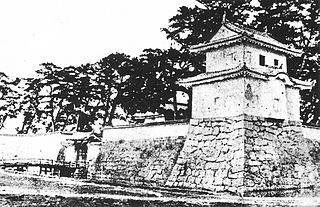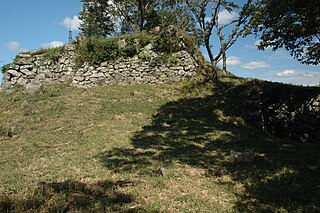
Himeji is a city located in Hyōgo Prefecture in the Kansai region of Japan. As of 1 June 2022, the city had an estimated population of 525,682 in 227,099 households and a population density of 980 persons per km2. The total area of the city is 534.35 square kilometres (206.31 sq mi).

Aioi is a city in Hyōgo Prefecture, Japan. As of 31 May 2022, the city had an estimated population of 28,208 in 13143 households and a population density of 310 persons per km2. The total area of the city is 90.4 square kilometres (34.9 sq mi).

Tatsuno is a city in Hyōgo Prefecture, Japan. As of 31 May 2022, the city had an estimated population of 74,414 in 31119 households and a population density of 6200 persons per km2. The total area of the city is 49.42 square kilometres (19.08 sq mi).

Inaba Province was a former province in the area that is today the eastern half of Tottori Prefecture in the San'in region of Japan. Inaba was bordered by Hōki, Mimasaka, Harima and Tajima Provinces. Its abbreviated form name was Inshū (因州). In terms of the Gokishichidō system, Inaba was one of the provinces of the San'indo circuit. Under the Engishiki classification system, Inaba was ranked as one of the 35 "superior countries" (上国) in terms of importance, and one of the "near countries" (近国) in terms of distance from the capital. The provincial capital was located in what is now the city of Tottori. The ichinomiya of the province is the Ube shrine also located in the city of Tottori.

Chizu is a town located in Yazu District, Tottori Prefecture, Japan. As of 1 January 2024, the town had an estimated population of 5,906 in 2681 households and a population density of 26.3 persons per km2. The total area of the town is 224.70 square kilometres (86.76 sq mi).

Inami is a town located in Kako District, Hyōgo Prefecture, Japan. As of 1 May 2022, the town had an estimated population of 30,622 in 12843 households and a population density of 880 persons per km². The total area of the town is 34.92 square kilometres (13.48 sq mi).

Kamigōri is a town located in Akō District, Hyōgo Prefecture, Japan. As of 1 March 2022, the town had an estimated population of 14,179 in 6426 households and a population density of 94 persons per km². The total area of the town is 150.26 square kilometres (58.02 sq mi).
Kōzuki was a town located in Sayō District, Hyōgo Prefecture, Japan.
Nankō was a town located in Sayō District, Hyōgo Prefecture, Japan.
Mikazuki was a town located in Sayō District, Hyōgo Prefecture, Japan.

Shisō is a city in Hyōgo Prefecture, Japan. As of 31 May 2022, the city had an estimated population of 35,639 in 14694 households and a population density of 110 persons per km². The total area of the city is 658.54 square kilometres (254.26 sq mi).

Tottori is the capital and the largest city of Tottori Prefecture in the Chūgoku region of Japan. As of 30 November 2022, the city had an estimated population of 183,383 in 81,732 households and a population density of 240 persons per km². The total area of the city is 765.31 square kilometres (295.49 sq mi). Most of the city is within the San'in Kaigan Geopark.

Yazu is a town located in Yazu District, Tottori Prefecture, Japan. As of 30 November 2022, the town had an estimated population of 16,156 in 6140 households and a population density of 78 persons per km². The total area of the town is 206.71 square kilometres (79.81 sq mi).

Akō Domain was a feudal domain under the Tokugawa shogunate of Edo period Japan, located in Harima Province in what is now the southwestern portion of modern-day Hyōgo Prefecture. It was centered around Akō Castle, which is located in what is now the city of Akō, Hyōgo.

Hirafuku Station is a passenger railway station located in the town of Sayō, Sayō District, Hyōgo Prefecture, Japan. It is operated by the third-sector semi-public railway operator Chizu Express.

Kōzuki Station is a passenger railway station located in the town of Sayō, Sayō District, Hyōgo Prefecture, Japan, operated by West Japan Railway Company.

The Inaba Kaidō (因幡街道) was a route built during the Edo period in Japan. It started in Himeji, Harima Province, and stretched to Tottori, Inaba Province. There were eleven post stations along the route connecting to two cities.

Mikazuki Domain was a feudal domain under the Tokugawa shogunate of Edo period Japan, in Harima Province in what is now the southwestern portion of modern-day Hyōgo Prefecture. It was centered around the Mikazuki jin'ya which was located in what is now the Mikazuki neighborhood of the town of Sayō, Hyōgo. It was controlled by a cadet branch tozama daimyō Mori clan throughout its history. It was also called Noino Domain.

Yamasaki Domain was a feudal domain under the Tokugawa shogunate of Edo period Japan, located in Harima Province in what is now the southwestern portion of modern-day Hyōgo Prefecture. It was centered around the Yamasaki jin'ya which was located in what is now the town of Yamasaki, Hyōgo. It was initially controlled by a cadet branch tozama daimyō Ikeda clan, but later came under the control of a cadet branch of the Honda clan. It was also called Shisō Domain

Rikan Castle was a Nanboku-chō to Sengoku period yamashiro-style Japanese castle located in the Hirafuku neighborhood of the town of Sayō, in far western Hyōgo Prefecture, Japan. The ruins have been protected as a National Historic Site since 2017.


























